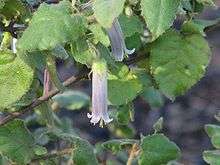Correa aemula
Correa aemula, commonly known as the hairy correa,[2] is a species of shrub that is endemic to south-eastern Australia. It has broadly heart-shaped leaves arranged in opposite pairs, green or greyish green, pendent flowers arranged singly or in pairs and ageing to mauve-purple.
| Hairy correa | |
|---|---|
 | |
| In Royal Botanic Gardens, Melbourne | |
| Scientific classification | |
| Kingdom: | Plantae |
| Clade: | Tracheophytes |
| Clade: | Angiosperms |
| Clade: | Eudicots |
| Clade: | Rosids |
| Order: | Sapindales |
| Family: | Rutaceae |
| Genus: | Correa |
| Species: | C. aemula |
| Binomial name | |
| Correa aemula | |
| Synonyms[1] | |
| |
Description
Correa aemula is an erect to spreading shrub that typically grows to a height of 2.5 m (8 ft 2 in) and has woolly-hairy branches. The leaves are papery, broadly heart-shaped, 10–60 mm (0.39–2.36 in) long and 5–35 mm (0.20–1.38 in) wide on a petiole 4–6 mm (0.16–0.24 in) long and covered with star-shaped hairs. The flowers are arranged singly, sometimes in pairs, in leaf axils or on the ends of short shoots, each on a pendent pedicel 5–30 mm (0.20–1.18 in) long. The calyx is cup-shaped with four lance-shaped lobes 4–8 mm (0.16–0.31 in) long. The petals are fused for most of their length, forming a cylindrical corolla 15–30 mm (0.59–1.18 in) long and green or greyish gren, fading to mauve-purple. The eight stamens extend slightly beyond the end of the petal tube. Flowering occurs in spring and summer.[2][3][4][5][6]
Taxonomy
The hairy correa was first formally described in 1838 by botanist John Lindley in Thomas Mitchell's book, Three Expeditions into the interior of Eastern Australia. Lindley gave the plant the name Didimeria aemula,[7] but in 1858, Ferdinand von Mueller, changed the name to Correa aemula in his book Fragmenta phytographiae Australiae.[8][9]
Distribution and habitat
Correa aemula occurs on sandy or rocky soils in open forests and heathy woodlands in the Mount Lofty Ranges and Kangaroo Island in South Australia and the Grampians in Victoria.[2][3][5][10] Hybrids with Correa decumbens and Correa reflexa have been recorded.[4]
References
- "Correa aemula". Australian Plant Census. Retrieved 9 July 2020.
- Duretto, Marco F. "Correa aemula". Royal Botanic Gardens victoria. Retrieved 9 July 2020.
- Wilson, Paul G.; Wilson, Annette J.G. (ed.); Bolton, P.E. (ed.). "Correa aemula". Australian Biological Resources Study, Department of Agriculture, Water and the Environment: Canberra. Retrieved 9 July 2020.CS1 maint: extra text: authors list (link)
- "Correa aemula". State Herbarium of South Australia. Retrieved 9 July 2020.
- "Correa aemula (Rutaceae) Hairy Correa". South Australian Seed Conservation Centre. Retrieved 9 July 2020.
- Wild Plants of Victoria CD-ROM. Bentleigh East, Victoria: Viridans Biological Databases & Department of Sustainability and Environment. 2003.
- "Didmeria aemula". APNI. Retrieved 9 July 2020.
- "Correa aemula". APNI. Retrieved 9 July 2020.
- von Mueller, Ferdinand (1858). Fragmenta phytographiae Australiae. Melbourne: Victorian Government Printer. p. 3. Retrieved 9 July 2020.
- Wilson, Paul G. (1961). "A taxonomic revision of the Genus Correa". Transactions of the Royal Society of South Australia. 85: 42–44. Retrieved 9 July 2020.